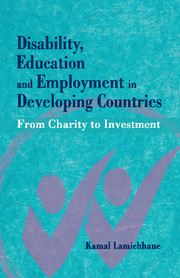Book contents
- Frontmatter
- Contents
- List of Tables and Figures
- Preface
- Acknowledgements
- 1 Fundamentals of Disability Studies
- 2 Disability and the Global Employment Situation
- 3 Disability and the Role of Education in Jobs: Case Studies from Nepal and the Philippines
- 4 Disability and Jobs in a Post-Conflict Country: Cambodia
- 5 Gender and Jobs: A Comparison between People with and without Disabilities in Bangladesh
- 6 Disability and Human Capital Investment
- 7 Disability, Poverty and Inequality: A Case Study in Nepal
- 8 Disability and Job Satisfaction Differentials
- 9 Disability and Determinants of Education: A Case from India
- 10 Disability and Barriers to Education
- 11 The Way Forward: Investment in Disability
- Index
- About the Author
5 - Gender and Jobs: A Comparison between People with and without Disabilities in Bangladesh
Published online by Cambridge University Press: 05 February 2015
- Frontmatter
- Contents
- List of Tables and Figures
- Preface
- Acknowledgements
- 1 Fundamentals of Disability Studies
- 2 Disability and the Global Employment Situation
- 3 Disability and the Role of Education in Jobs: Case Studies from Nepal and the Philippines
- 4 Disability and Jobs in a Post-Conflict Country: Cambodia
- 5 Gender and Jobs: A Comparison between People with and without Disabilities in Bangladesh
- 6 Disability and Human Capital Investment
- 7 Disability, Poverty and Inequality: A Case Study in Nepal
- 8 Disability and Job Satisfaction Differentials
- 9 Disability and Determinants of Education: A Case from India
- 10 Disability and Barriers to Education
- 11 The Way Forward: Investment in Disability
- Index
- About the Author
Summary
Introduction
Due to the lack of empirical studies on participation in the labour market of people with disabilities in Bangladesh, the factors that play a crucial role in maximizing their labour force participation are as yet unidentified. In this chapter, I attempt to fill the lacuna in the existing literature and provide empirical evidence on the importance of education to enable the labour market participation of people with disabilities in Bangladesh. I believe that the research presented in this chapter will be of assistance to the government of Bangladesh and other relevant authorities in formulating policies to ensure the inclusive participation of people with disabilities in education and the labour market.
The questions posed in this chapter are: Is there any difference between the determinants of employment of people with and without disabilities? Is there any difference in the employability and the occupational choices of men and women with disabilities? The distinction of this chapter from previous chapters is that, rather than comparing the labour market participation and occupational distinctions within impairment groups and relying on relatively small samples, this chapter presents the employment situation of people with and without disabilities, using a large and nationally representative dataset produced by the Bangladesh Bureau of Statistics (BBS) with the technical support of the World Bank. This dataset includes for the first time questions about disability, making it possible to look at different impairment groups – for example – people with hearing, physical and visual impairments, followed by people with cognitive impairments or communication problems. Another important feature of this chapter is that, because the dataset includes questions on the severity of impairment, I also compare the labour market participation of people with moderate and severe impairments.
Another distinguishing feature is that this chapter provides empirical analysis not only of the impact of different impairments on employment but also the intersection between impairment, gender and employment. For women with disabilities, the situation might be worsened as they may suffer from dual discrimination – first as a woman and second as a person with a disability.
- Type
- Chapter
- Information
- Disability, Education and Employment in Developing CountriesFrom Charity to Investment, pp. 85 - 111Publisher: Cambridge University PressPrint publication year: 2015



